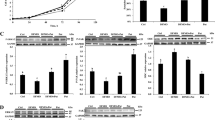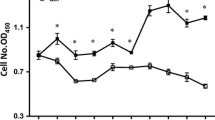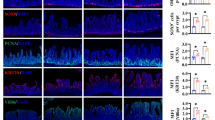Abstract
Dietary supplementation with N-acetylcysteine (NAC) has been reported to improve intestinal health and treat gastrointestinal diseases. However, the underlying mechanisms are not fully understood. According to previous reports, NAC was thought to exert its effect through glutathione synthesis. This study tested the hypothesis that NAC enhances enterocyte growth and protein synthesis independently of cellular glutathione synthesis. Intestinal porcine epithelial cells were cultured for 3 days in Dulbecco’s modified Eagle medium containing 0 or 100 μM NAC. To determine a possible role for GSH (the reduced form of glutathione) in mediating the effect of NAC on cell growth and protein synthesis, additional experiments were conducted using culture medium containing 100 μM GSH, 100 μM GSH ethyl ester (GSHee), diethylmaleate (a GSH-depletion agent; 10 μM), or a GSH-synthesis inhibitor (buthionine sulfoximine, BSO; 20 μM). NAC increased cell proliferation, GSH concentration, and protein synthesis, while inhibiting proteolysis. GSHee enhanced cell proliferation and GSH concentration without affecting protein synthesis but inhibited proteolysis. Conversely, BSO or diethylmaleate reduced cell proliferation and GSH concentration without affecting protein synthesis, while promoting protein degradation. At the signaling level, NAC augmented the protein abundance of total mTOR, phosphorylated mTOR, and phosphorylated 70S6 kinase as well as mRNA levels for mTOR and p70S6 kinase in IPEC-1 cells. Collectively, these results indicate that NAC upregulates expression of mTOR signaling proteins to stimulate protein synthesis in enterocytes independently of GSH generation. Our findings provide a hitherto unrecognized biochemical mechanism for beneficial effects of NAC in intestinal cells.






Similar content being viewed by others
Abbreviations
- BSO:
-
Buthionine sulfoximine
- DEM:
-
Diethylmaleate
- GSH:
-
Glutathione
- GSHee:
-
Glutathione ethyl esters
- HMBS:
-
Hydroxymethylbilane synthase
- HPRT1:
-
Hypoxanthine phosphoribosyltransferase 1
- mTOR:
-
Mammalian target of rapamycin
- RPL19:
-
Ribosomal protein L19
- 4E-BP1:
-
4E-binding protein-1
References
Barajas-Espinosa A, Basye A, Jesse E et al (2014) Redox activation of DUSP4 by N-acetylcysteine protects endothelial cells from Cd2+-induced apoptosis. Free Radic Biol Med 74:188–199
Bruel T, Guibon R, Melo S et al (2010) Epithelial induction of porcine suppressor of cytokine signaling 2 (SOCS2) gene expression in response to Entamoeba histolytica. Dev Comp Immunol 34:562–571
Cossarizza A, Franceschi C, Monti D et al (1995) Protective effect of N-acetylcysteine in tumor necrosis factor-alpha-induced apoptosis in U937 cells—the role of mitochondria. Exp Cell Res 220:232–240
Fu WJ, Stromberg AJ, Viele K et al (2010) Statistics and bioinformatics in nutritional sciences: analysis of complex data in the era of systems biology. J Nutr Biochem 21:561–572
Haynes TE, Li P, Li X et al (2009) l-Glutamine or L-alanyl-L-glutamine prevents oxidant- or endotoxin-induced death of neonatal enterocytes. Amino Acids 37:131–142
Hou Y, Wang L, Zhang W et al (2012) Protective effects of N-acetylcysteine on intestinal functions of piglets challenged with lipopolysaccharide. Amino Acids 43:1233–1242
Hou Y, Wang L, Yi D et al (2013) N-acetylcysteine reduces inflammation in the small intestine by regulating redox, EGF and TLR4 signaling. Amino Acids 45:513–522
Hou YQ, Wang L, Yi D, Wu G (2015) N-acetylcysteine and intestinal health: a focus on its mechanism of action. Front Biosci 20:872–891
Huang TS, Duyster J, Wang JY (1995) Biological response to phorbol ester determined by alternative G1 pathways. Proc Natl Acad Sci 92:4793–4797
Iantomasi T, Favilli F, Degl’Innocenti D et al (1999) Increased glutathione synthesis associated with platelet-derived growth factor stimulation of NIH3T3 fibroblasts. Biochim Biophys Acta 1452:303–312
Jones DP, Go YM, Anderson CL et al (2004) Cysteine/cystine couple is a newly recognized node in the circuitry for biologic redox signaling and control. FASEB J 18:1246–1248
Kim KY, Rhim T, Choi I et al (2001) N-acetylcysteine induces cell cycle arrest in hepatic stellate cells through its reducing activity. J Biol Chem 276:40591–40598
Kong X, Tan B, Yin Y et al (2012) L-Arginine stimulates the mTOR signaling pathway and protein synthesis in porcine trophectoderm cells. J Nutr Biochem 23:1178–1183
Lai ZW, Hanczko R, Bonilla E et al (2012) N-acetylcysteine reduces disease activity by blocking mammalian target of rapamycin in T cells from systemic lupus erythematosus patients: a randomized, double-blind, placebo-controlled trial. Arthritis Rheum 64:2937–2946
Lee MF, Chan CY, Hung HC et al (2013) N-acetylcysteine (NAC) inhibits cell growth by mediating the EGFR/Akt/HMG box-containing protein 1 (HBP1) signaling pathway in invasive oral cancer. Oral Oncol 49:129–135
Levy EJ, Anderson ME, Meister A (1993) Transport of glutathione diethyl ester into human cells. Proc Natl Acad Sci 90:9171–9917
Li P, Kim SW, Li X et al (2008) Dietary supplementation with cholesterol and docosahexaenoic acid increases the activity of the arginine-nitric oxide pathway in tissues of young pigs. Nitric Oxide 19:259–265
Liu M, Wikonkal NM, Brash DE (1999) Induction of cyclin-dependent kinase inhibitors and G1 prolongation by the chemopreventive agent N-acetylcysteine. Carcinogenesis 20:1869–1872
Markovic J, Mora NJ, Broseta AM et al (2009) The depletion of nuclear glutathione impairs cell proliferation in 3T3 fibroblasts. PLoS One 4:e6413
Mårtensson J, Jain A, Meister A (1990) Glutathione is required for intestinal function. Proc Natl Acad Sci 87:1715–1719
Mayer M, Noble M (1994) N-acetyl-l-cysteine is a pluripotent protector against cell-death and enhancer of trophic factor-mediated cell-survival in-vitro. Proc Natl Acad Sci 91:7496–7500
Meurens F, Berri M, Auray G et al (2009) Early immune response following Salmonella enterica subspecies enterica serovar Typhimurium infection in porcine jejunal gut loops. Vet Res 40:5
Nygard A, Jøgensen CB, Cirera S et al (2007) Selection of reference genes for gene expression studies in pig tissues using SYBR green qPCR. BMC Mol Biol 8:67
Ozdemir R, Yurttutan S, Sari FN et al (2012) Antioxidant effects of N-acetylcysteine in a neonatal rat model of necrotizing enterocolitis. J Pediatr Surg 47:1625–1627
Romagnoli C, Marcucci T, Picariello L et al (2013) Role of N-acetylcysteine and GSH redox system on total and active MMP-2 in intestinal myofibroblasts of Crohn’s disease patients. Int J Colorectal Dis 28:915–924
Ruiz E, Siow RC, Bartlett SR et al (2003) Vitamin C inhibits diethylmaleate-induced l-cystine transport in human vascular smooth muscle cells. Free Radic Biol Med 34:103–110
Samuni Y, Goldstein S, Dean OM et al (2013) The chemistry and biological activities of N-acetylcysteine. Biochim Biophys Acta 1830:4117–4129
Shen HM, Yang CF, Ding WX et al (2001) Superoxide radical-initiated apoptotic signalling pathway in selenite-treated HepG(2) cells: mitochondria serve as the main target. Free Radic Biol Med 30:9–21
Shingaki T, Nimura N (2011) Improvement of translation efficiency in an Escherichia coli cell-free protein system using cysteine. Protein Expr Purif 77:193–197
Smith PK, Krohn RI, Hermanson GT et al (1985) Measurement of protein using bicinchoninic acid. Anal Biochem 150:76–85
Suryawan A, O’Connor PMJ, Bush JA et al (2009) Differential regulation of protein synthesis by amino acids and insulin in peripheral and visceral tissues of neonatal pigs. Amino Acids 37:105–110
Tan B, Yin Y, Kong X et al (2010) l-Arginine stimulates proliferation and prevents endotoxin-induced death of intestinal cells. Amino Acids 38:1227–1235
Wang Q, Hou Y, Yi D et al (2013) Protective effects of N-acetylcysteine on acetic acid-induced colitis in a porcine model. BMC Gastroenterol 13:133
Wang W, Dai Z, Wu Z et al (2014) Glycine is a nutritionally essential amino acid for maximal growth of milk-fed young pigs. Amino Acids 46:2037–2045
Wei JW, Carroll RJ, Harden KK et al (2012) Comparisons of treatment means when factors do not interact in two-factorial studies. Amino Acids 42:2031–2035
Wu G (2009) Amino acids: metabolism, functions, and nutrition. Amino Acids 37:1–17
Wu G, Thompson JR (1990) The effect of glutamine on protein turnover in chick skeletal muscle in vitro. Biochem J 265:593–598
Wu G, Fang YZ, Yang S et al (2004) Glutathione metabolism and its implications for health. J Nutr 134:489–492
Wu G, Bazer FW, Dai ZL et al (2014) Amino acid nutrition in animals: protein synthesis and beyond. Annu Rev Anim Biosci 2:387–417
Xi P, Jiang Z, Dai Z et al (2012) Regulation of protein turnover by l-glutamine in porcine intestinal epithelial cells. J Nutr Biochem 23:1012–1017
Yang L, Tan P, Zhou W et al (2012) N-acetylcysteine protects against hypoxia mimetic-induced autophagy by targeting the HIF-1α pathway in retinal ganglion cells. Cell Mol Neurobiol 32:1275–1285
Yao K, Yin Y, Li X et al (2012) Alpha-ketoglutarate inhibits glutamine degradation and enhances protein synthesis in intestinal porcine epithelial cells. Amino Acids 42:491–2500
Yi D, Hou Y, Wang L et al (2015) L-Glutamine enhances enterocyte growth via activation of the mTOR signaling pathway independently of AMPK. Amino Acids 47:65–78
Zhu L, Cai X, Guo Q et al (2013) Effect of N-acetyl cysteine on enterocyte apoptosis and intracellular signalling pathways’ response to oxidative stress in weaned piglets. Br J Nutr 110:1938–1947
Acknowledgments
This research was jointly supported by the National Natural Science Foundation of China (Nos. 31372319, 31572416, 31402084), the Hubei Provincial Key Project for Scientific and Technical Innovation (2014ABA022), Hubei Provincial Research and Development Program (No. 2010BB023), Natural Science Foundation of Hubei Province (Nos. 2013CFA097, 2012FFB04805, 2011CDA131), the Hubei Hundred Talent Program, Agriculture and Food Research Initiative Competitive Grants of (2014-67015-21770) of the USDA National Institute of Food and Agriculture, and Texas A&M AgriLife Research (H-82000).
Author information
Authors and Affiliations
Corresponding author
Ethics declarations
Conflict of interest
The authors declare that they have no conflict of interest.
Rights and permissions
About this article
Cite this article
Yi, D., Hou, Y., Wang, L. et al. N-acetylcysteine stimulates protein synthesis in enterocytes independently of glutathione synthesis. Amino Acids 48, 523–533 (2016). https://doi.org/10.1007/s00726-015-2105-z
Received:
Accepted:
Published:
Issue Date:
DOI: https://doi.org/10.1007/s00726-015-2105-z




